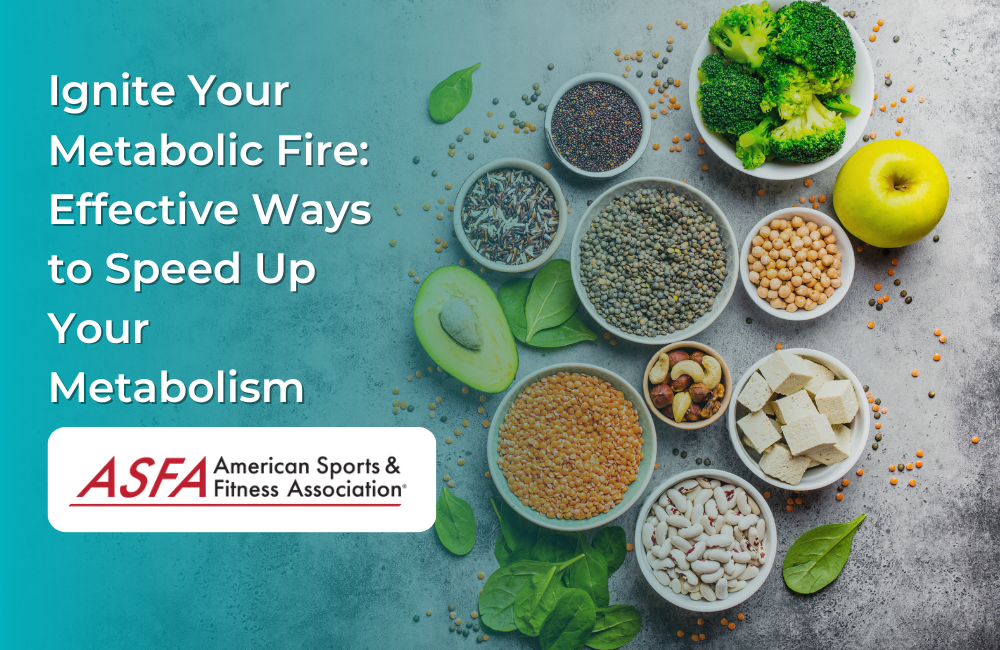Metabolism is a complex process that plays a critical role in how our bodies convert food into energy, influencing everything from daily energy levels to weight management and overall health. As a leading organization in fitness education, the American Sports and Fitness Association (ASFA) recognizes the importance of understanding how metabolism works and how to optimize it for better energy utilization and fat loss. This comprehensive guide will explore the various factors affecting metabolism and provide detailed strategies to help you naturally increase your metabolic rate, promoting effective weight management, increased energy, and improved overall well-being.
Understanding Metabolism
-
Metabolism Defined: Metabolism refers to all chemical processes within the body that are involved in converting food into energy. These processes are divided into two main categories:
-
Catabolism: The breakdown of food and nutrients into smaller components, releasing energy the body can use for its functions.
-
Anabolism: The process of using energy to build and repair tissues, including muscle and other cell structures.
Together, these processes ensure the body has the energy it needs for everything from breathing and digestion to physical activity and repair.
-
-
Basal Metabolic Rate (BMR): Your BMR is the number of calories your body needs to maintain essential physiological functions—such as breathing, circulation, and cell production—while at rest. This makes up a large portion of your total daily energy expenditure (TDEE). Knowing your BMR helps you understand how many calories your body needs daily just to sustain itself, even without additional activity.
Factors Affecting Metabolism
-
Age: Metabolism typically slows with age due to a natural decrease in muscle mass and changes in hormonal levels. After age 30, muscle mass tends to decrease by about 3-5% per decade, leading to fewer calories burned at rest.
-
Body Composition: The ratio of muscle to fat in your body is one of the most significant factors influencing metabolism. Lean muscle tissue requires more energy to maintain than fat, so individuals with a higher proportion of muscle tend to have a faster metabolism.
-
Genetics: Your genetic makeup plays a role in determining your metabolic rate. Some people naturally have a higher or lower metabolism, which can influence their ability to gain or lose weight.
-
Hormonal Changes: Hormones like thyroid hormones (T3 and T4) and insulin directly affect metabolic processes. Conditions like hypothyroidism or hyperthyroidism can significantly slow down or speed up metabolism. Additionally, fluctuations in sex hormones (estrogen and testosterone) can also impact metabolic rate, particularly as you age.
Strategies to Speed Up Your Metabolism
-
Strength Training and Building Muscle:
a. Muscle Burns More Calories: Muscle tissue burns more calories than fat, even when at rest. For every pound of muscle, the body burns approximately 6 calories per day at rest, while fat burns only about 2 calories per pound. Therefore, increasing muscle mass is an effective way to elevate your metabolic rate.
b. Resistance Training: Engaging in regular strength training exercises such as weightlifting, resistance bands, or bodyweight exercises (push-ups, squats, etc.) helps build and maintain lean muscle. Aim for 2-3 strength training sessions per week, focusing on all major muscle groups.
-
High-Intensity Interval Training (HIIT):
a. Boosts Metabolism During and After Exercise: HIIT workouts, which involve alternating short bursts of intense exercise with recovery periods, increase calorie burn not only during the workout but also for hours afterward. This is due to the body's need to restore oxygen and energy levels after intense exertion, a process known as excess post-exercise oxygen consumption (EPOC).
b. Efficient and Time-Saving: HIIT can be done in shorter periods than traditional cardio, typically lasting between 20-30 minutes. Examples include sprint intervals, burpees, or jump squats, performed in 30-second intense bursts followed by 1-2 minutes of rest.
-
Stay Active Throughout the Day:
a. Non-Exercise Activity Thermogenesis (NEAT): NEAT refers to the calories burned through everyday activities like walking, standing, cleaning, or even fidgeting. Increasing NEAT throughout the day can have a significant impact on your overall calorie expenditure.
b. Frequent Movement: Incorporate small activities like taking the stairs, walking short distances, standing during work, or engaging in light stretching to keep your metabolism active throughout the day. Even small movements can add up to a substantial calorie burn over time.
-
Eat Adequate Protein:
a. Thermic Effect of Food (TEF): The thermic effect of food is the increase in metabolism that occurs after eating, due to the energy required to digest, absorb, and process nutrients. Protein has the highest TEF of all macronutrients, requiring about 20-30% of its calories to be used for digestion and metabolism, compared to 5-10% for carbohydrates and 0-3% for fats.
b. Satiety and Muscle Maintenance: High-protein diets not only keep you feeling full for longer but also help preserve lean muscle mass during weight loss, preventing your metabolism from slowing down. Aim to include protein-rich foods like chicken, fish, eggs, legumes, and dairy in each meal.
-
Stay Hydrated:
a. Hydration and Metabolism: Water plays a crucial role in all metabolic processes. Dehydration can slow down your metabolism, as the body needs adequate water to efficiently burn calories and break down fat.
b. Cold Water for a Temporary Boost: Drinking cold water can slightly boost metabolism because the body expends extra energy to warm the water to body temperature. Aim to drink at least 8 cups of water per day, more if you are physically active.
-
Include Healthy Fats:
a. Fat-Burning Properties: Consuming healthy fats, such as those found in avocados, nuts, seeds, and olive oil, helps maintain a healthy metabolism by supporting hormone production and reducing inflammation, which can affect metabolism.
b. Omega-3 Fatty Acids: Omega-3s, found in fish like salmon, as well as flaxseeds and walnuts, are particularly beneficial for metabolism because they help reduce inflammation, which can interfere with the body's ability to burn fat efficiently.
-
Avoid Crash Diets:
a. Metabolic Slowdown: Extreme calorie restriction slows down metabolism as the body tries to conserve energy by reducing the number of calories it burns. This can lead to muscle loss, further reducing metabolic rate.
b. Sustainable Weight Loss: Instead of drastic calorie cuts, aim for a moderate caloric deficit (500-700 calories per day), which allows for steady fat loss without triggering metabolic adaptation or muscle loss.
-
Eat Small, Frequent Meals:
a. Thermic Effect of Feeding (TEF): Eating small, frequent meals (every 3-4 hours) can keep your metabolism more active by maintaining the thermic effect of food and preventing long periods of fasting that might slow down your metabolic rate.
b. Stable Blood Sugar Levels: Regular meals can help maintain stable blood sugar levels, preventing energy crashes and overeating later in the day.
-
Get Sufficient Sleep:
a. Impact on Hormones: Sleep deprivation disrupts the balance of hunger hormones, such as ghrelin (which increases appetite) and leptin (which signals fullness), leading to increased cravings and overeating. Lack of sleep can also lead to insulin resistance, making it harder for the body to metabolize carbohydrates efficiently.
b. Rest and Recovery: Aim for 7-9 hours of sleep per night to allow your body to recover, repair muscle, and regulate hormones that support a healthy metabolism.
-
Manage Stress:
a. Cortisol and Metabolism: Chronic stress increases cortisol levels, which can lead to increased fat storage, particularly around the abdomen. Elevated cortisol can also slow metabolism and encourage cravings for high-fat, high-sugar foods.
b. Stress-Reducing Techniques: Incorporate stress-relief practices such as yoga, meditation, deep breathing exercises, or mindfulness to keep cortisol levels in check and support a healthy metabolism.
-
Spicy Foods:
a. Thermogenic Effect: Spicy foods, particularly those containing capsaicin (found in chili peppers), have a thermogenic effect, meaning they can temporarily increase calorie burn by raising body temperature.
b. Capsaicin and Calorie Burn: Adding spices like cayenne pepper or hot sauce to meals can enhance calorie burning by stimulating the body's metabolic response.
The Importance of a Balanced Approach
-
Individual Variations: Each person's metabolism responds differently to lifestyle changes, so it's essential to experiment with different strategies to find what works best for you. Factors like genetics, age, and existing medical conditions play a role in how effective metabolism-boosting tactics will be.
-
Personalization: Tailoring your approach based on your unique body composition, activity levels, and health status is key. Consider consulting with a fitness professional or dietitian to develop a customized plan that aligns with your personal goals.
First Aid and CPR Training
-
Holistic Health Approach: ASFA promotes a comprehensive health approach that includes not only fitness and nutrition but also emergency preparedness. Gaining knowledge in first aid and CPR empowers individuals to respond effectively in emergencies, promoting safety and well-being in the community.
Conclusion
Boosting your metabolism naturally can help you achieve your fitness and weight management goals while improving your overall well-being. ASFA encourages adopting a well-rounded approach to metabolic health through strength training, HIIT workouts, staying active throughout the day, eating a balanced diet, and maintaining proper hydration. Additionally, managing stress, getting enough sleep, and incorporating strategies like eating more protein and healthy fats will further support your metabolism. Personalizing your approach and focusing on long-term, sustainable changes are the keys to success. By incorporating emergency response training such as first aid and CPR, you can enhance both your personal health and the safety of those around you, contributing to a healthier, more resilient community.





